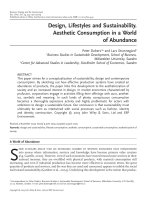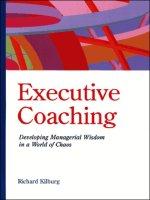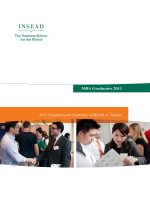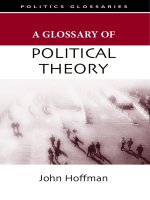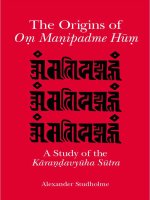yale university press a world of letters yale university press 1908-2008 oct 2008
Bạn đang xem bản rút gọn của tài liệu. Xem và tải ngay bản đầy đủ của tài liệu tại đây (1.48 MB, 238 trang )
A World of Letters
Yale University Press
–
.
Yale University Press
Published with assistance from the Norman V. Donaldson Memorial Fund
and the foundation established in memory of Philip Hamilton McMillan
of the Class of , Yale College.
Copyright © by Yale University.
All rights reserved.
is book may not be reproduced, in whole or in part, including
illustrations, in any form (beyond that copying permitted by Sections and
of the U.S. Copyright Law and except by reviewers for the public press),
without written permission from the publishers.
Designed by James J. Johnson and set in Adobe Caslon by
Duke & Company, Devon, Pennsylvania.
Printed in the United States of America by Sheridan Books.
Library of Congress Cataloging-in-Publication Data
Basbanes, Nicholas A., –
A world of letters : Yale University Press, – / Nicholas A. Basbanes.
p. cm.
Includes bibliographical references.
---- (alk. paper)
. Yale University Press—History. . University presses—Connecticut—
New Haven—History—th century. . Scholarly publishing—
Connecticut—New Haven—History—th century. I. Title.
.
.′—dc
A catalogue record for this book is available from the British Library.
is paper meets the requirements of / .-
(Permanence of Paper). It contains percent postconsumer waste ()
and is certifi ed by the Forest Stewardship Council ().
For Constance V. Basbanes
Preface, ix
e Formative Decades,
e Middle Years,
Enriching the Mix,
A Press in Transition,
Notes,
Centennial Highlights,
Illustrations follow pages 80 and 128
Contents
[ ix ]
e centennial of Yale University Press comes at a time when
scholarly publishers everywhere are considering creative ways
to remain viable in the face of what all agree is a “crisis” in the
way they have always gone about their business. With the ad-
vent in recent years of what we might call the “electronic alter-
native” to traditional publishing—a development of such un-
precedented consequence that the whole notion of book culture
is a topic of unending speculation—the role of the university
press in the twenty-fi rst century has become a hot topic.
Beyond the long shadow cast by the computer, a good
deal of the concern stems from the steady erosion of a core
market, with so many academic and research libraries no lon-
ger buying books that once came to them routinely on stand-
ing order, eliminating what was once a dependable outlet for
even the most esoteric of monographs. Added to that trend has
been the continued disappearance of the independent book-
store, reduced budgets for the buying of books exacerbated by
the skyrocketing cost of scholarly journals, and the growing
Preface
x
dominance of online retailers, each a factor that, in its own
way, has had a rippling eff ect on scholarly publishing.
To appreciate the degree of unease that is endemic, one
need only read University Publishing in a Digital Age, a de-
tailed report released in July that was prepared collabora-
tively by Laura Brown, former president of Oxford University
Press USA, and Ithaka, a nonprofi t research and consulting
organization focused on higher education and technology.
Described by its authors as a “qualitative review” of material
gathered from a survey of American university presses, the
report drew also on interviews conducted with press directors,
librarians, provosts, and other administrators. Among their
fi ndings was evidence that university presses suff er from “a
drift” in which they have become “less integrated with the core
activities and missions of their home campuses.” To combat
this disquieting trend, the authors of the report have proposed
a joint undertaking that would assume many of the techno-
logical and marketing functions that most presses are unable
to aff ord on their own—one that would involve less reliance
on traditional bookmaking.
Without naming names, the authors report that “the
need for university presses is being questioned at some institu-
tions,” with administrators throughout the country “looking
to other parts of campus (most commonly libraries) to assume
publishing related responsibilities for digital content,” while
others are reconsidering the way their presses are governed
and operated. A good deal of all this anxiety, naturally, is at-
xi
tributed to the “fi nancial stability”—or lack thereof—at so
many of the presses, particularly “as demand for their tra-
ditional products declines and administrators’ appetites for
subsidizing them diminish.”
To emphasize the latter point, the Ithaka Report noted
that of eighty-eight scholarly presses based in American uni-
versities, fi fty-three responded to the survey, and of these,
percent reported that their parent institutions allow them “to
operate at a defi cit.” Given that the thirty-fi ve presses that
did not respond to the survey are almost entirely small (the
identities of the respondents are listed in an appendix)—and
since the Ithaka Report makes clear that “large presses gener-
ally are faring better than smaller” ones—it is not a stretch to
speculate that the percentage of scholarly presses operating
in the red each year is closer to percent.
Taking all of these factors into account, the authors of
the report ask the following question: “Ten years from now,
how many university presses will be able to compete for au-
thors, or meet the expectations of consumers of scholarly in-
formation online, if they only continue what they are doing
today?” eir answer—“very few, we expect”—provides the
thrust of this prediction: “Publishing in the future will look
very diff erent than it has in the past.” Describing this as “a
pivotal moment,” the authors further maintain that “scholarly
publishing of the future will need to support content created
in new and complex ways, including everything from regularly
updated reference material, multimedia projects, and large
xii
interlinked centers that add new works regularly, to resources
user-generated content.”
As bold and as pointed as the Ithaka Report may be—
and it is being read carefully throughout the publishing in-
dustry—few of its conclusions come as a surprise to anyone
who has paid attention to what has been happening over the
past couple of decades. It was largely for this reason, in fact,
that I welcomed the opportunity to write a history of Yale
University Press on its one hundredth birthday. I have been
writing about various aspects of books and book culture for
thirty years, beginning as the literary editor of a newspaper in
Massachusetts, then as a syndicated columnist and freelance
writer, and now as the author of seven books to date that have
taken in the gamut of this endlessly fascinating world. With
that as a stock-in-trade, the off er to enter the life of what I
have long regarded as one of the truly outstanding scholarly
publishers in the world was irresistible. To have an opportu-
nity to determine how this publisher has managed not only
to survive in the face of such formidable obstacles—but to
fl ourish and thrive—seemed a perfect fi t.
Because “fi nancial stability,” as the authors of the Ithaka
Report put it, does matter in scholarly publishing, it is relevant
to report that in Yale University Press fi nished well in the
black, a circumstance that has become an annual expectation at
Yale. Although continued fi scal health is impressive, what is es-
pecially pertinent are the publishing goals these revenues allow
the Press to achieve—the central thrust of this narrative.
xiii
“Yale University Press has a special history,” one of the
many people I interviewed over the past three years for this
book told me early on in my research. “We are leading the
way toward a new kind of university publishing.” Little did I
know then how lively the history would be, and how engaging
the experiences of the principals. Yet for all the enthusiasm I
may profess for what Yale University Press has accomplished,
it is important to note that I remain an outsider, and that
one of the many inducements I had to take on this project
was a commitment from the Press to honor every request for
information I might have and to provide access to whatever
fi les or records I wished to examine. It is gratifying to report
that every document I requested was furnished, everyone I
wanted to interview was made available, and every interview
I conducted was helpful and informative. I wish in this regard
to express my gratitude to everyone at the Press past and pres-
ent who provided so much encouragement and assistance, in
particular to John Donatich, John Ryden, Janyce Siress, Laura
Jones Dooley, and Sarah Clark, and also to Caroline Kelley, a
graduate student whose searches on my behalf in the archives
of Sterling Memorial Library during the early months of this
project were most helpful.
e motto of Yale University is lux et veritas—light
and truth—words that have special relevance to a publishing
enterprise whose goal it is to create an enduring world of
letters. May the next hundred years be equally illuminating,
equally enriching.
[ ]
form of publishing enterprise that has
emerged globally by way of two strikingly
diff erent sets of circumstances. Certainly
the most venerable operations are to be
found in the United Kingdom at Oxford
and Cambridge Universities, where both institutions main-
tain publishing enterprises with pedigrees that extend back
more than half a millennium, each established around the
time that the earliest printing shops were being set up in
England by William Caxton and his followers. First to issue
a book under its name was Oxford, with the release in of
an obscure commentary on the Apostles’ Creed attributed to
Jerome; it was printed by eodoric Rood, a German expatri-
ate credited with producing seventeen titles for the university
through . Despite such a fruitful beginning, output there
was haphazard and inconsistent at best over the next century,
ONE
e Formative Decades
and production did not become fi rmly institutionalized until
, when the Star Chamber—at the urging of the earl of
Leicester, the university chancellor and a favorite of Queen
Elizabeth I—granted Oxford a decree confi rming its privilege
to print books. irty-fi ve years later, the university received
royal permission to produce and sell the King James Autho-
rized Version of the Bible, an extraordinary concession that
assured profi tability in the centuries to come and contributed
measurably to a long period of sustained growth that would
be highlighted by such early eff orts as Sir Francis Bacon’s
Advancement of Learning (), Captain John Smith’s Map
of Virginia (), and Robert Burton’s Anatomy of Melancholy
(). e Crown granted similar permission to Cambridge
University Press, which had been established in . Before
long Cambridge would be publishing the original writings
of such luminaries as John Milton, John Dryden, William
Harvey, Isaac Newton, James Clerk-Maxwell, and Lord Kel-
vin, works of lasting literary and scientifi c signifi cance that
set a pattern for generations to come. But it was the steady
sale of Bibles, many millions of them over the decades, that
assured fi nancial stability for both imprints and made possible
the steady publication of other worthy eff orts that continue
to distinguish their names and bring credit to their parent
institutions.
In the New World, as with everything else, the histori-
cal record is far more truncated than the European example,
with the American form of academic press emerging in the
late nineteenth and early twentieth centuries as a response
to the professionalization of scholarship then taking place
throughout the United States and Canada, and as a way to
document the pioneering work being produced. Two of the
earliest endeavors to begin operations in North America did
so as deliberate components of newly established research
institutions. e Johns Hopkins University Press—the old-
est university press in continuous operation in the United
States—was formed in , just two years after the institution
itself opened under the leadership of Daniel Coit Gilman, an
imaginative educator who famously declared that one of the
“noblest duties” of a university is to “advance knowledge and
to diff use it not merely among those who can attend the daily
lectures—but far and wide.” When that bold statement of
purpose was proclaimed, the promulgation of ideas to points
“far and wide” meant intellectual enrichment by means of the
printed word. Gilman’s point, made simply, was that if ideas
and discoveries were to be shared, they had to appear fi rst
between the hard covers of bound books or as articles and
essays in reputable journals, a conviction he nurtured dur-
ing his nine-year tenure (–) as college librarian and
professor of physical and political geography at Yale, where
he received his bachelor’s degree in , and as president of
the University of California from to .
A similar dynamic took place at the University of Chi-
cago, an institution established in by John D. Rockefeller
with a clear mandate to stimulate probing inquiry among
a new generation of carefully trained scholars. Like Johns
Hopkins, this new center of learning was conceived as a nexus
of primary research that would develop specialized graduate
programs then unheard of in the United States but common
in Europe. William Rainey Harper, the founding president,
was a brilliant strategist whose innovative approach was to
combine the interdisciplinary strength of American liberal
arts colleges with the rigorous structure of German research
universities. An essential element of success, he made clear,
was the immediate organization of a publishing unit that
would be an “organic part of the institution,” not an “incident”
or informal “attachment” to the overall scheme. e formation
of a press was included in his original plans for the university,
created, in fact, as one of four major divisions, to be controlled
by a special committee of trustees but operated as a private
corporation. Harper’s strategy paid immediate dividends; by
, the press had published books and pamphlets and set
up eleven scholarly journals featuring original contributions in
education, the social sciences, the humanities, and the physical
sciences. In , Albert A. Michelson, a University of Chicago
physicist credited with determining the speed of light, became
the fi rst American scientist to receive a Nobel Prize; the books
outlining many of his fi ndings— e Velocity of Light (),
Light Waves and eir Uses (), and Studies in Optics ()—
were published by the University of Chicago Press, which
today claims twenty Nobel laureates among its authors.
Rounding out the fi rst generation of North American
academic presses were the University of California and Co-
lumbia University, which both established publishing divi-
sions in , followed by the University of Toronto in .
In the early years of the twentieth century, the founding spirit
at Columbia, Nicholas Murray Butler—philosopher, diplo-
mat, winner in of a Nobel Peace Prize, and from to
president of both the university he transformed and the
press he urged into being to serve it—had expressed repeated
concern that “marked activity” in the production of original
research being done on the Morningside Heights campus
was not reaching a broad audience because such “contribu-
tions to knowledge are always of a technical character and
usually destitute of commercial value.” e only alternative,
he felt, was to set up a publishing unit that would support
the massive expansion in advanced educational programs he
was introducing at Columbia and ensure that the product of
these pursuits was disseminated widely.
In , the New York publisher Charles Scribner, Prince-
ton Class of and a Princeton trustee, took the initiative to
get a publishing operation up and running at his alma mater.
Scribner had been toying with ways to go about publishing
scholarly monographs not feasible for commercial ventures
when he was presented with a proposal to support an inde-
pendent academic press. In addition to furnishing seed money,
Scribner bought the land for the headquarters, furnished it with
printing equipment, and underwrote construction of a build-
ing designed by his brother-in-law, the architect Ernest Flagg.
His ideal for the press, according to an editorial in the New
York Herald Tribune, was to promote “disinterested service
to Literature.” Incorporated as a self-supporting corporation
to be operated apart from the university—an arrangement
that continues there to this day—Princeton University Press
would publish nearly four hundred books in its fi rst twenty
years and provide the conceptual model for three enterprising
Yale graduates who were intent on establishing a nonprofi t
publishing enterprise of their own a few years later.
e Yale trio included George Parmly Day, Class of ,
and his older brother, Clarence S. Day, Jr., Class of , the
sons of Clarence Shepard Day, Sr., Class of , a prominent
New York broker, banker, railroad director, and for many years
governor of the New York Stock Exchange; they were also the
grandsons of Benjamin Henry Day, the founder of the New
York Sun, and the nephews of Benjamin Day, the inventor in
of an engraving process used in commercial printing to
add shading, texture, and tone to images that continues to
bear the name Benday. In , the Day brothers received the
blessing of Yale president Arthur Twining Hadley to orga-
nize what they modestly chose to call the Yale Publishing
Association and to take operational control of the Yale Alumni
Weekly; they also introduced a scholarly quarterly, the Yale
Review, that in time would achieve world renown and by
midcentury operate on its own. Joining them in their modest
undertaking was a classmate of Clarence’s, Edwin Oviatt, who
would edit the alumni weekly and later write an institutional
history published by the Press in , e Beginnings of Yale
(1701–1726). eir careful eff ort to publish e Journal of an
Expedition across Venezuela and Columbia by Yale professor
Hiram Bingham—an accomplished explorer soon to be ac-
claimed as the discoverer of Machu Picchu and later to serve
as a United States senator from Connecticut—increased their
standing with President Hadley, who in allowed them
to call their enterprise Yale University Press, with the explicit
understanding that the university would monitor its activities.
In , as Hadley refl ected on his two decades as Yale presi-
dent, he deemed the Yale Review and Yale University Press to
have been “our best products of the past twenty years.”
Sickly for much of his adult life—he died in at age
sixty-one—Clarence Day, Jr., achieved celebrity as an author,
most famously of a best-selling memoir of growing up in
Manhattan in the s as one of four sons in an affl uent East
Side household headed by a domineering father. Published
fi ve months before his death, Life with Father became the
basis of a comedy adapted for the stage by Howard Lindsay
and Russel Crouse. It opened on Broadway in and ran
for a record , performances; a fi lm starring William
Powell, Irene Dunne, and a very young Elizabeth Taylor re-
ceived Oscar nominations for cinematography, art direction,
musical score, and best actor.
Apart from lending his full enthusiasm to the Press, Clar-
ence Day was content to allow his younger brother be the prime
mover in the ambitious initiative, which began operations
not in New Haven but in New York, where George Parmly
Day was gainfully employed in his father’s Wall Street broker-
age fi rm and in no position, just yet, to give up his day job. e
enterprise briefl y set up its headquarters in what he described
years later as a “ten by twelve” room before moving into a mar-
ginally larger space—“a little black cave” of an offi ce—in the
Ginn Building at Fifth Avenue near Washington Square.
e workforce during that embryonic period consisted entirely
of George Day’s wife, Wilhelmine Octavia Johnson Day, who
was responsible for keeping a record of all the Press’s work
“in a ridiculous book, four by seven, with a thin cover that
looked like butchers’ paper,” according to a charming remi-
niscence written by Clarence Day, Jr., in . Each morn-
ing, Clarence Day recalled in the chatty piece, Wilhelmine
“rushed” to the front door of the building to see if the post-
man “had shoved any mail through the slot of the door; and
when some of it was orders she had to telephone downtown
at once to announce them, because orders make you happy
when you are starting a publishing business. One morning
there was a splendid order for thirty-one books, and it took
her all day to get them tied up and sent off and billed for.”
Long after a full-time staff was in place handling Press
aff airs in New Haven, Wilhelmine Day retained an abiding
interest in its well-being. An orphan raised by a guardian,
and childless throughout her fi fty-seven-year marriage to
George Parmly Day, she was a formidable presence, and not
shy about off ering an opinion. Such was the case in , when
she returned from a trip to Europe and urged her husband to
publish an overview of economic reform then being attempted
in Sweden as a response to world depression, an experiment
in government that would later be described as a “constructive
compromise between capitalism and socialism.” Following her
advice, the Press commissioned Marquis W. Childs, a young
foreign correspondent for the St. Louis Post-Dispatch who had
reported from Stockholm, to write Sweden: e Middle Way,
which in became an international best seller, so infl uential
that Yale published a sequel, Sweden: e Middle Way on Trial,
forty-four years later. Alvin Eisenman, founder and director
of the graphic design program at the Yale School of Art and
one in a long line of great printers and graphic designers to
work at the Press, told Roberta Yerkes Blanshard, an editorial
employee from to , about a telephone call he received
from the boss’s wife on his fi rst day of employment as a Yale
typographer in . “Mr. Eisenman,” she told him, “I want
you to know that Mr. Day and I never had any children. e
Yale Press is our child, and I want you to treat it carefully.” At
that point, according to Eisenman, “Click, she hung up. And
never mentioned it again.”
Clarence Day’s good-natured essay “ e Story of the
Yale University Press Told by a Friend” refl ected lightly on the
fi rst dozen years of the bold publishing project he had under-
taken with his brother and was written with the idea that it
might persuade prospective donors to help the operation se-
cure fi nancial stability beyond what they were able to commit
